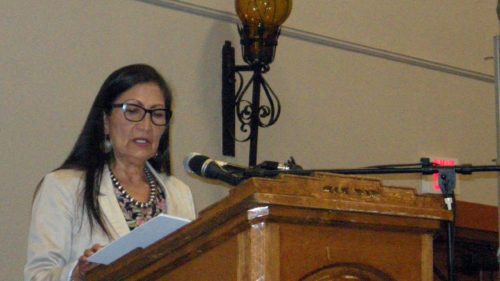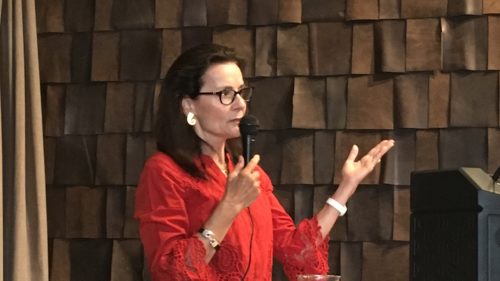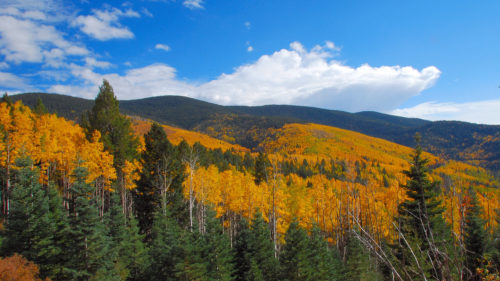By BEN NEARY
NMWF Conservation Director
ALBUQUERQUE — It’s time for the public to demand a halt to New Mexico’s latest effort to divert water out of the Gila River, a chief critic of the project says.
Norm Gaume, a former director of the New Mexico Interstate Stream Commission, spoke about the Gila Diversion Project on Wed., July 10, in Albuquerque as part of the New Mexico Wildlife Federation’s monthly conservation series.
Gaume, an engineer, has been a relentless critic of the Gila project since 2013. From 1997 until 2002, he served as director of the New Mexico Interstate Stream Commission, which has responsibility for developing the state’s water supply. Before that, he was water resources manager for the City of Albuquerque. He’s now retired.
Gaume, an avid boater, said the Gila River holds a special place. “We talk about it in terms of being one of the West’s last free-flowing rivers,” he said. While there are some irrigation diversions on the river, he said there are no major, large-scale water development projects on it.
“The river retains its wild character,” Gaume said. “It flash-floods, it creates new courses, it moves around. It has amazing diversity because of this. Because it’s a wild river, it’s home to seven federally listed endangered species.”
The diversion project now under consideration is the latest in a series of proposals dating back to the 1960s that each has considered taking water from the Gila in New Mexico before it flows into Arizona. Gaume said each has been rejected ultimately as being too expensive, environmentally harmful and because there wasn’t demand for the water.
The Gila River flows out of the Gila Wilderness, the nation’s first designated wilderness. The American Rivers group this spring named the Gila River as the top river on its list of the nation’s most endangered rivers, citing not only the threat of the proposed diversion project but also the effects of climate change.
“New Mexicans can’t afford to dry up their last wild river,” Matt Rice, Colorado Basin director for American Rivers, said in April. “Ruining the Gila River with an expensive diversion project doesn’t make sense when there are better, more cost-effective water supply options.”
Over the years, powerful New Mexico senators have insisted that Congress approve money for water projects on the Gila River as a condition of allowing water projects in Arizona to move forward, Guame said. This has placed the U.S. Bureau of Reclamation in the unusual position of evaluating New Mexico projects that already have funding even before there’s been an engineering analysis of whether they’re feasible or economical.
In 2004, Congress gave New Mexico a choice of either accepting federal funding to meet regional water needs across four counties in the southwestern corner of the state or to hold out for a larger pot of money to build a diversion project on the Gila. The Interstate Stream Commission in 2014 opted for the diversion project.
The commission created an entity, called the New Mexico Central Arizona Project Entity, to handle the planning effort. The entity has spent over $15 million on planning so far, but Gaume and other critics say there’s little to show for it.
Recent plans have called for diverting water from two locations on the Gila River and from one location on the San Francisco River, a Gila tributary. However, the U.S. Bureau of Reclamation, the federal agency handling environmental review of the project, has expressed concerns about whether the project planning can meet looming federal deadlines.
The NMCAP Entity this month voted to scale back the Gila project to bring it under budget. As it stands now, Gaume said it would cost roughly $50 million but produce only about 1,300 acre feet of water a year to benefit fewer than 100 irrigators. An acre foot is the amount of water that covers and acre to a depth of one foot.
Despite spending 15 years and $15 million years planning the project, Gaume said Wednesday the NMCAP Entity has not prepared a feasibility study, benefit-cost evaluation or preliminary engineering report of the alternatives.
A recent preliminary draft environmental impact statement evaluated the project and concludes it would cost $3 million a year to provide enough water to grow crops with a market value of only $1.5 million, Gaume said.
“So the whole thing’s just upside down,” Gaume said.
He said the main environmental study of the project is due at the end of the year, but said New Mexico is unlikely to make the deadline. He said it would be up to the U.S. Secretary of Interior whether to grant an extension, but said such an extension is supposed to be granted only if the delay is not the fault of the state.
Gov. Michelle Lujan Grisham, who took office this year, campaigned on opposing the Gila project. She vetoed some planning money for the project earlier this year and has said she wants the remaining project money, about $75 million, spent on other water supply projects in southwestern New Mexico.
Nonetheless, the Interstate Stream Commission voted recently to continue project planning, using nearly $1 million in leftover money that had been allocated last year. Lujan Grisham, a Democrat, has yet to appoint ISC members to replace those appointed by her predecessor, Republican Susana Martinez.
Stopping work on the Gila project now would free up about $75 million in federal funding that could be used on other water supply projects in the four counties of southwestern New Mexico, Gaume said. One such project, the Grant County Regional Water Project, would supply water to roughly 26,000 people in mining communities such as Bayard and Hurley.
Gaume urged people in the audience on Wednesday to contact members of the state’s congressional delegation to oppose the diversion project. And he encouraged people to write letters to the editor of newspapers in the state expressing their concerns about “what a dog this is.”
Gaume also urged people to contact Lujan Grisham and ask her to fulfill her campaign pledge to stop the project. “Add your voice to putting an end to this project, as our current governor has promised,” he said.
Gaume spoke at Marble Brewery’s Northeast Heights location at 9904 Montgomery Blvd., NE, in Albuquerque. The brewery is hosting NMWF talks on conservation issues starting at 5:30 p.m. on the second Wednesday of each month.



